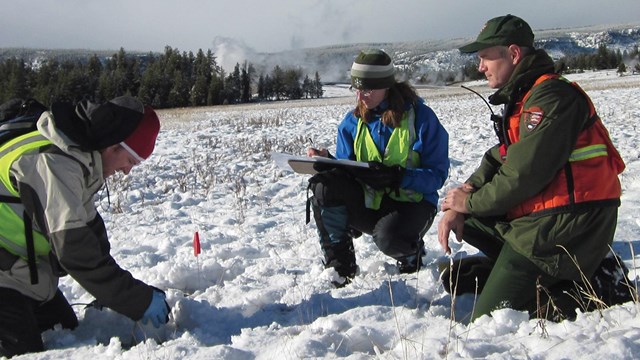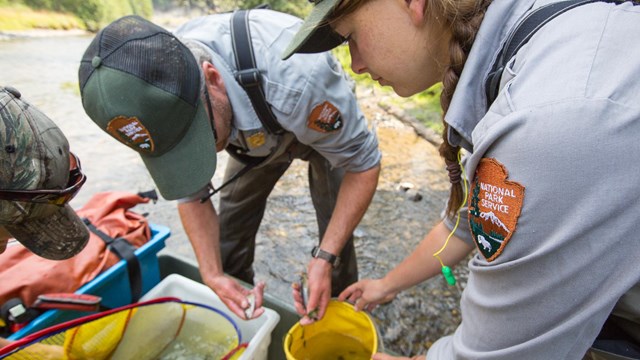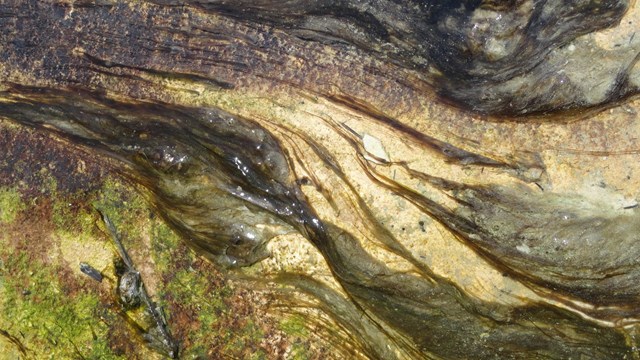
William H. Jackson A Long History of Scientific StudySome of the first written accounts about the wildlife and thermal features of the Greater Yellowstone area were in journals and letters from settlers, trappers, Indian scouts, and the military. These early accounts brought about expeditions to explore Yellowstone in the 1860s and 1870s. It is in these explorations that the history of science in Yellowstone formally began with the expeditions of geologist Ferdinand V. Hayden, who led official government expeditions to the Yellowstone area in the 1870s. 
NPS Modern ResearchBy the 1960s, scientific research in Yellowstone had extended beyond the study of the park itself. Yellowstone was also a place where researchers advanced techniques for scientific study. The National Park Service changed its permitting policy at this time, requiring researchers to demonstrate their projects directly benefited park managers and would help make important decisions. As a result, many permits were denied. This gave some permit-seekers the impression that research in the park was not as welcome as it had been in the past. Around this time, the National Park Service also adopted a goal to host mission-oriented research, and managers sometimes felt free to suggest researchers accordingly adjust their proposals to meet that goal. As important as wildlife science has been in Yellowstone’s history, the park’s hot springs have demonstrated immeasurable scientific value. In 1966, researcher Thomas Brock discovered Thermus aquaticus, a microorganism capable of surviving in temperatures extreme enough to kill most other living organisms, in a Yellowstone hot spring. In 1985, the Cetus Corporation obtained a sample of T. aquaticus for use in developing the Polymerase Chain Reaction (PCR) process for rapidly replicating DNA. Amplifying a segment of DNA to a billion exact copies in a few hours gives a scientist enough material to seriously study. The use of an enzyme discovered in T. aquaticus, called Taq polymerase (which does not break down at the high temperatures required in the PCR process), made PCR practical and is seen as the biggest advance in PCR. Today, PCR is still the main process used to study nucleic acids, and DNA sequencing is a multibillion dollar business. More than 53 patents involve research from Yellowstone. Research studies provide valuable information to the park. Dozens of comprehensive studies were completed in the 20 years following the 1988 fires. The restoration of wolves in 1995 lead to increased research interest on the complex interactions on the northern range and continues today. The active volcanic ecosystem also fuels a wide variety of geologic studies. Many of these scientific studies have ramifications far beyond Yellowstone National Park. Research Projects in YellowstoneToday, permitted researchers study everything from archeology to zoology. Current research examples include:

Research in the Park
All scientists in Yellowstone work under research permits and are closely supervised by National Park Service staff. 
Science & Research
Learn more about the science that informs management decisions and has the potential to the changes lives everywhere. 
Bioprospecting
Bioprospecting is the discovery of useful scientific information from genetic or biochemical resources. ResourcesMarcus, W.A., J.E. Meacham, A.W. Rodman, A.Y. Steingisser. 2012. Atlas of Yellowstone. University of California Press. Wondrak Biel, Alice. 2004. The bearer has permission: A brief history of research permitting in Yellowstone National Park. Yellowstone Science 12(3):5–20. National Park Service Research Permit and Reporting System: https://irma.nps.gov/rprs |
Last updated: April 18, 2025
